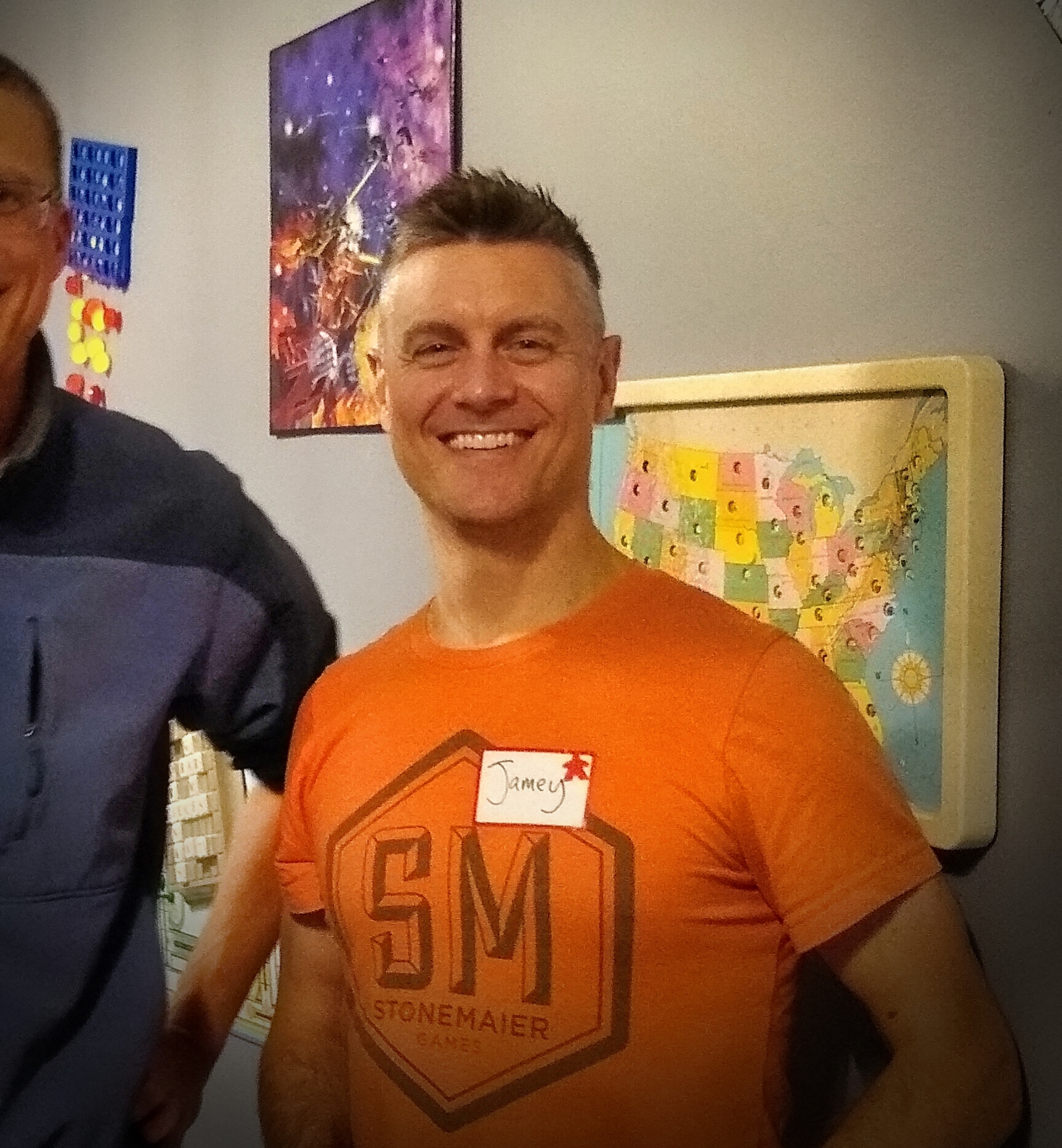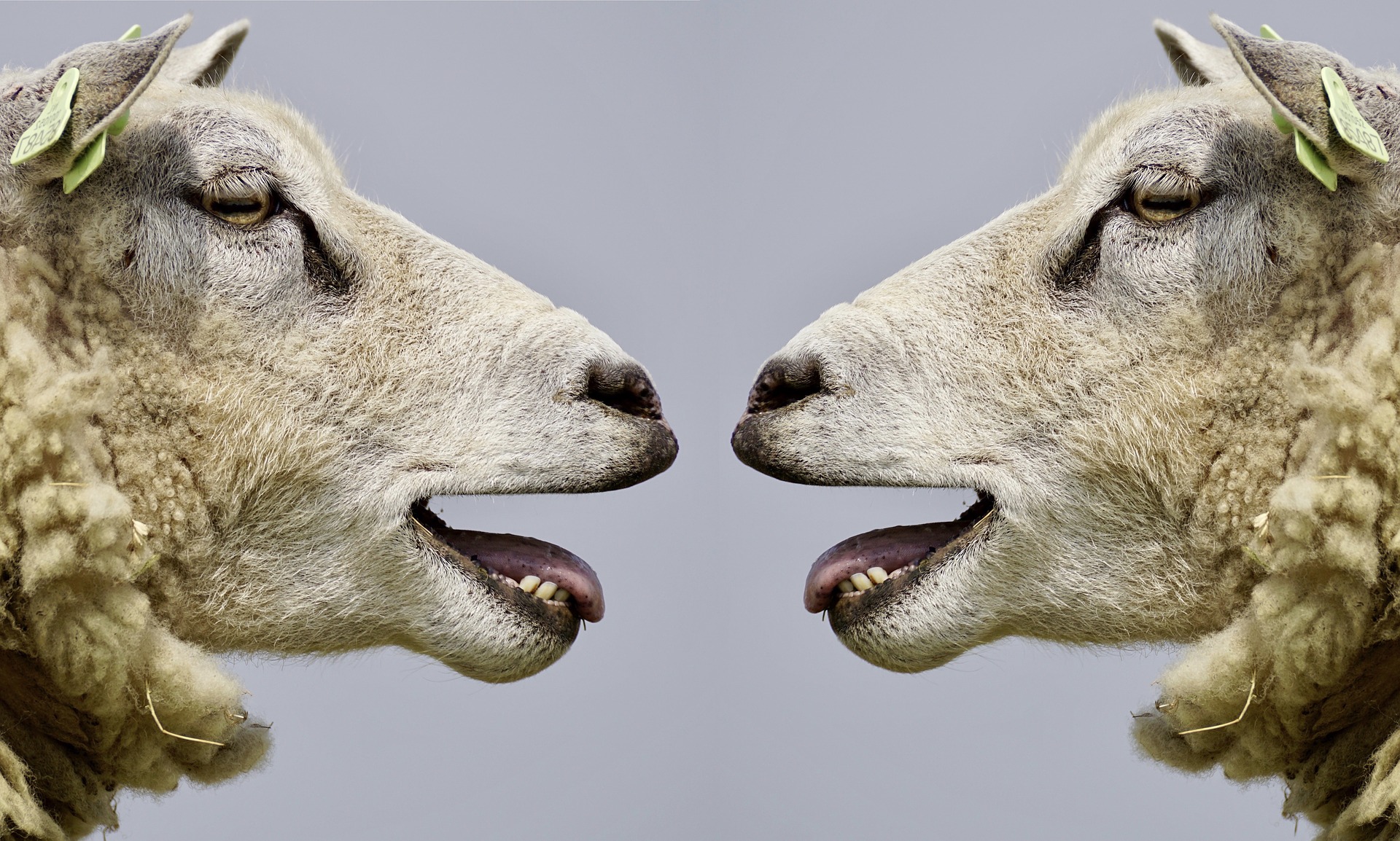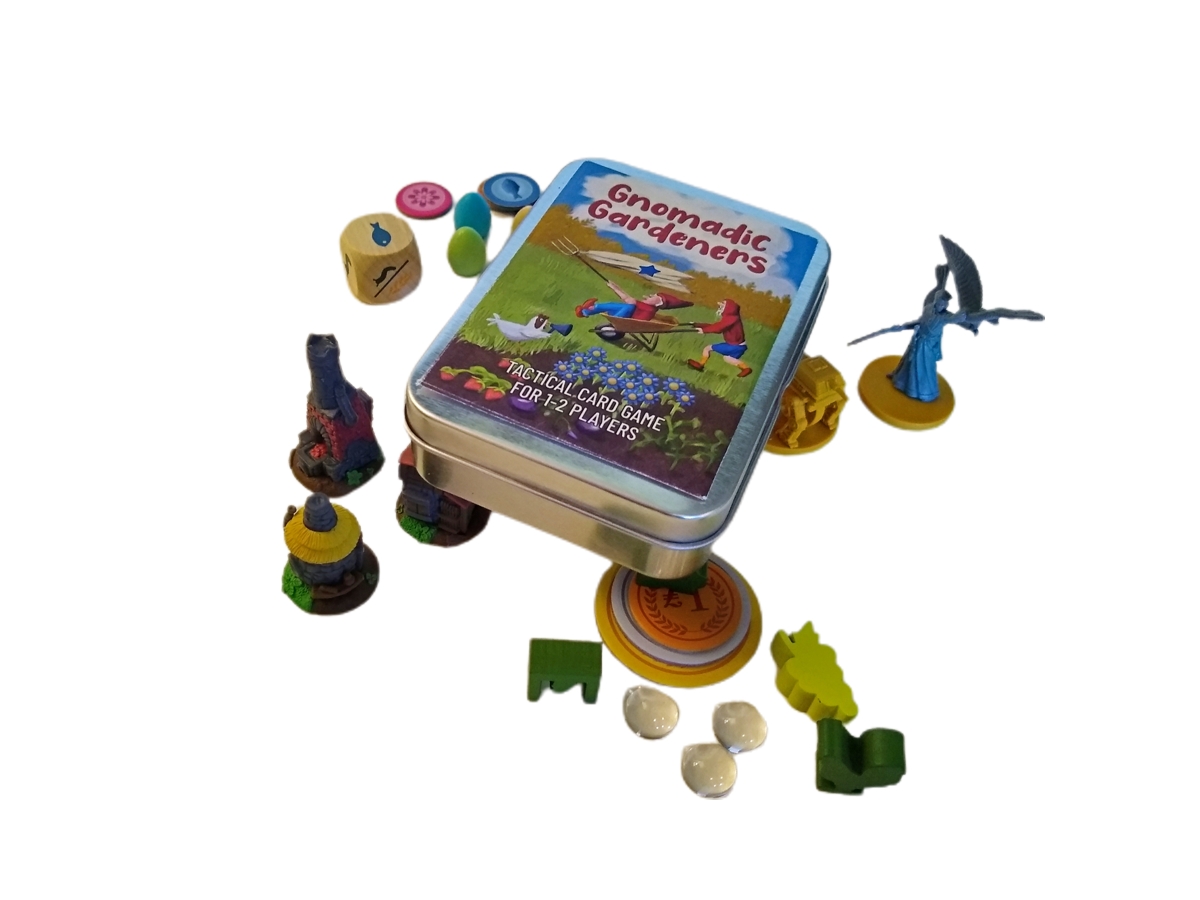Gnomadic Gardeners launches today on Kickstarter. It’s a pocket-sized engine-builder about garden gnomes for 1-2 players. I hope that you check it out.
The launch creates an occasion to acknowledge some excellent advice from colleagues–and to draw attention to these people. I’ve tried to follow their advice as best as I can. Thanks to you all!
Jamey Stegmaier
As illustrated by the photograph in the heading above, my success largely rests on attempting to follow the positive examples set by Stonemaier Games.
I’m an unabashedly huge fan of Stonemaier both due to many shared game-design philosophies and due my respect for Jamey Stegmaier’s massive personal contributions to the game industry.
My mental nickname for Jamey is “The Consigliere of Kickstarter” (no nefarious connotations intended, Jamey!) He literally wrote the book on Kickstarting a game. If you don’t have a copy and plan to do a Kickstarter, then I hope you literally buy a copy immediately. (Don’t worry, this article will still be here when you get back.)
He also has run an online semi-weekly book club gathering over the past few months, in which he’s answered questions from those of us still learning the ropes of crowdfunding. You can watch the replays.
Prior to moving away from crowdfunding, Jamey always aimed for much bigger campaigns than I’m hoping to achieve with my first Kickstarter (which I view as something of a practice run for larger campaigns to come). If I hit 100 backers, I’ll be a happy camper.

Despite the big difference between Jamey’s campaign goals and my own, much of Jamey’s advice has applied to my situation. As hinted in the illustration above, his expertise extends beyond the games that he has Kickstarted to include design of other games as well as publication of games by other designers. As a result, his blog posts on other topics and the hundreds of videos that he’s recorded on game design have been a huge resource.
Here are just a few ways that Jamey’s advice has affected my campaign:
- Start a blog: I would not have started this blog if Jamey hadn’t suggested blogging. The primary purpose is not to draw an audience but, rather, to practice communication about games. Though I was a professor in my prior career, I hadn’t written for general audiences. It’s a different style of communicating with pictures and personality than what researchers usually use. I’m still learning.
- Give net value: Jamey pounds the message of providing value. It’s become my mantra, whether selling or simply sharing, in all things I try to give more than I take.
- Set realistic prices and funding target: Long after I wanted to just say “good enough,” Jamey’s advice drove me to spend a lot of time designing and refining component combinations and pricing levels that would avoid losing money yet still remain priced similarly to other small card games, without having to charge extra shipping after the campaign.
- Be a community member: He urges us to become part of the wider gaming community before Kickstarting. This has been a HUGE stretching experience for me. Prior to 2021, I hardly ever posted on social media and certainly not in a relational way. After all, professors are generally expected to be performative, not collaborative. I’m having to unlearn over a decade of experience. (To any professors reading: please assume you’re an exception and take no offense ;> )
Jamey’s example has influenced and impacted my career in so many other ways. Thanks, Jamey.
Jasper Gardener Burch
Jamey’s shove to start blogging led me to study Jasper’s excellent blog on Pine Island Games. There, he discusses the many challenges that he has encountered and overcome in successfully launching his first game, Nut Hunt. They’re now working toward launching SIGIL.
Jasper influenced me in a few ways:
- Don’t overlook the gameplay: Jasper nudged me make the gameplay portion of my campaign page clearer and more detailed, and to draw out the special aspects of the game’s mechanics.
- Streamline, streamline, streamline: Professors get paid more if they use big words and long sentences. (Kidding. Sort of.) Jasper pointed out many areas of my campaign page that I needed to make concise.
- Don’t sweat the ads: Jasper found that advertising on Facebook cost him more than it generated. I’ve been on the fence, but his experience (and that of a few other publishers recently) convinced me to forego paid advertising. We’ll see how that goes.
Jasper sets a great example for focused execution. He plans big and swings for the fence, but he’s analytical and disciplined in how he pursues his goals. Thanks for your encouragement and advice, Jasper.

BGDL Facebook Group
Jamey’s shove to become part of the broader community led me to join the Board Game Design Lab’s Facebook group, which is an excellent resource for game designers and developers. As my game approached launch, their feedback influenced me in several ways.
- Tighten up the video: BGDL members advised a length of 1:30 at most, and I tried. Just when I thought I had it, another member of the group advised me to put in some content from the reviews. I ended up cutting and cutting and tightening and trimming — ending up around 2:00. We’ll see whether the analytics, in the end, give me some guidance for future videos.
- Brighten up the art: My original box art used less saturated, more natural colors, which some reviewers disliked. The Facebook group helped me choose among alternate designs, leading to the final version. They also helped me choose among different icon options.
- Give substantive $1 rewards: I polled BGDL for their favorite $1 rewards (as backers). Their top option, access to the pledge manager, was a non-starter because I am omitting that for simplicity on this first campaign (see Simplify Fulfillment below). Their 2nd and 3rd choices made it into my campaign: access to future beta-tests and a screensaver. These beat out non-substantive rewards (a thank you or something lighthearted).
If you’re a game designer who likes podcasts, check out the back catalog of podcasts that BGDL recorded over the years before ending this year.
Other colleagues
It would be hard to list all the other bits of advice that I’ve gleaned from colleagues on the web. These are in addition to specific edits on the campaign page that my friend and fellow designer Adam Michaud suggested to me. Here are some pages that I’ve bookmarked and referenced periodically, or which contain really great advice that helped me as I came into the final stretch…
Expectations
- Expect skepticism: Chris Wray mathematically analyzed BGG trends and found that crowd-funded games aren’t as good as traditionally-funded games, at least in terms of long-term BGG scores. He argues that crowd-funded games often wow with miniatures and table presence, then fail to deliver on gameplay. All that stuff increases bloat and cost, which ultimately can turn people off and can cause buyer’s remorse. This, along with cost considerations, drove me to redouble my efforts to polish the gameplay. I’m encouraged that the reviews have been strong for my game’s mechanics, but we’ll see if that holds in the long-term.
- Expect problems: Bryan at Game Brigade and Michael at the King of Average both argue that a huge problem with the industry is poor communication, coupled with a lack of proactiveness and quality control. Having interacted with quite a few publishers and self-publishers, my impression is that they are pulled in a ton of different directions, leaving them too little time for careful communication. Consequently, I’ve largely cleared my schedule for the next 2-3 months (no other major projects at all, and only one small side-project as time permits). That way, as problems arise, I can address them and communicate as well as I am capable.
- Don’t fear failing: Brian Husk, Gergely Gombos, and many other Kickstarter creators have demonstrated how to learn from a failed launch — then tried again. As long as I don’t waste a lot of money on up-front costs (such as marketing for a failed campaign), I can try again. That’s also one reason why I opted to Kickstart a small card game for my first campaign, as it takes a lot less up-front capital than a large game with miniatures and/or many parts.
Simplify fulfillment
Speaking of expectations, what I’ve read about shipping and fulfillment complexity convinced me to focus solely on Continental US distribution for my first campaign. I expect this to limit my potential number of backers, which in turn limits my number of copies. I reflected this expectation by ratcheting down my funding target and commensurately raising my cost per copy. I expect negligible profit at 100 copies. Nonetheless, the last thing that I want is a fulfillment fiasco. Much better a small success than a big failure!

Here’s a bit of what I’ve read and seen…
- While it may seem as simple as setting up an Amazon FBA account and just send product to Amazon warehouses for distribution, you can’t actually list a product on Amazon before Kickstarting it, and Amazon has become a pain for managing listings.
- Jason Glover at Grey Gnome Games has moved entirely to crowd-sales, in large part because of the time-consuming hassle of handling self-fulfillment. I might try his strategy of crowd-selling instead of crowd-funding for a future game.
- Alex Sender Radcliffe called out CMON for issuing huge post-campaign shipping charges to backers. More recently, he also recapped the fulfillment mess with Everrain/Quartermaster.
I’ll surely do international fulfillment on some future game. But if even CMON can’t get shipping in the current environment, I really don’t think it’s the time for me to learn how to do it.
Audience
- Find your fit: Brandon the Game Dev has a wonderfully concise summary of marketing and brand as it applies to kickstarting a game. It ultimately led me to decide that my publishing company was going to focus on weefolk, which I had earlier used in Tomten.
- If I do a good job of creating several games with great mechanics driven by that theme, then I’ll be “the weefolk guy” in a few years (or, failing that, maybe the “gnome guy”).
- And having a line of games tangentially linked by theme will avoid restricting me to a single universe yet facilitate moving non-gamers from relatively light games toward heavier games that have similar theme and interest.
- Focus on reaching gamers: All of us want to publish the next Wingspan that brings millions of new people into gaming.
- But realistically, most Kickstarters aren’t interesting to non-gamers unless they are based on expensive existing IP.
- Kickstarter already presents many barriers to entry for people who are unfamiliar with crowdfunding. These include conceptual barriers, the hassle of creating an account, and the need to enter payment information at the end of the campaign–not to mention the post-campaign survey and/or pledge manager. Somebody who isn’t a gamer and isn’t familiar with Kickstarter isn’t going to back you.
Channels and platforms
With a goal of only 100 backers or so, I didn’t need to build a massive crowd. However, I did at least need to get the word out through a few marketing channels. Here’s some advice I found, in addition to the great advice in Jamey’s book.
- Treat BGG appropriately: Dan & Stephanie at Letiman Games give great instructions, which I tried to follow step by step, about how and where to post in BoardGameGeek (BGG) about a game. BGG is not an audience; it’s a community. As such, it’s never appropriate just to blast self-promotion at BGG, and I’ve frequently had to step back and reconsider if what I was posting was appropriately on-topic.
- Build some buzz: Petter Schanke Olsen interviewed 40 Kickstarter creators to document their tactics. I digested this into a menu of available options, from which I selected those that seemed to offer a high reward-to-effort ratio. Posting on Facebook, building a TTS demo, sending physical demo copies to previewers, posting a BGG work-in-progress thread, sharing preliminary artwork, and segmenting contacts to plan communication all were do-able. And this leaves me a menu of other actions that I can try later in this campaign or in later campaigns.
- Create a Facebook group (I didn’t do this one): The Crowd Funding Nerds advise creating a Facebook group and use it to drive traffic to a landing page, where you can acquire and engage an audience. I opted not to follow this advice (which Jamey and Jasper also gave) for this first Kickstarter because other successful creators for similar small card games have tended not to start game-specific groups — but I’ll consider it for the future, particularly if I ever crowd-fund a board game.
- Look ahead to Gamefound: Aaron Marks enumerates many problems with Kickstarter, including the lack of meaningful feature development oriented toward game creators. I find Kickstarter’s ongoing lack of willingness to remit VAT on creators’ behalf to be particularly annoying (and is a key reason why I’m not shipping to Europe). GameFound has that feature, and as its community is growing quickly, it will become increasingly attractive as a venue for future campaigns.

Presentation
- Provide great imagery: Many people, including Tony at Board Game Quest as well as Jamey, emphasize the importance of high-quality photos, images and art. I don’t have a fancy camera, and my smartphone does a so-so job with focus, contrast and color. The need to post-process my pictures ultimately drove me to spend money on photo-editing software when I might otherwise have been tempted to go cheap.
- Don’t look scammy: There are periodically campaigns that just don’t look right. Overturn, for example, had a weirdly low funding target, poor communication and few photos (vs renders). Jamey advises backing a lot of campaigns before running one, which has the benefit of giving a feel for what’s reasonable and what’s not. (Aside from these issues, Overturn might have plagiarized from CMON which goes beyond just looking scammy.)
If you’ve given me advice and not gotten a thank you above, please forgive me. I’m happy to add your name!
And thank you as well to the friends and other players who have looked at my Kickstarter page and given feedback. Special thanks to Adam, Ali, Don, Jacob, Erika and Sam — all of whom endured multiple requests for playtesting and feedback over the past few months. I’m blessed to have so many supportive friends!

This is a great article with lots of useful stuff. It’s an honour to be mentioned alongside some of these other authors. Congrats on reaching your funding goal!
Thanks! You’ve got a lot of useful stuff on your own site, too — Hanabi was a great pick to cover! https://parsnippost.com/2022/01/04/table-for-two-hanabi/